“I want to sing like birds sing, not worrying who listens or what they think.”
–Rumi
“Keep a green tree in your heart and perhaps a singing bird will come.”
–Chinese Proverb
INTRODUCTION
On 19th February 2023 (the Dharma Protector Day before Losar) , I attended the final day of the Kagye Drubchen held at Tashi Jong Monastery near Palampur, Himachal Pradesh, presided over by the Drukpa Kagyu lineage head, 9th Khamtrul Rinpoche. Also participating in the ritual were several Togden yogis, with their dreadlocked hair and ngagpa robes. They spend their whole lives in retreat and only come out for big rituals and days such as this one. One of the Togden had dreadlocks so thick that his head looked like a bird’s nest on top!
This was the first time I had visited the Tashi Jong monastery, which is about one and half hours taxi drive from Dharamsala, with hills on all sides. In 2012, I attended the Chod empowerment and teaching given by HH 17th Karmapa at the nearby Dorzong Monastery, for more on that see here.
In this article there is an overview of:
– the Kagye and its connection to the Drukpa Kagyu, and personal photos and description of the remarkable tormas and event at Tashi Jong in February 2023.
-the Khamtrul Rinpoche lineage, in particular the 8th Khamtrul Rinpoche from Tibet, his founding of Tashi Jong Monastery in India, his connection to the 16th Karmapa and Dilgo Khyentse RInpoche and his renowned student, British nun, Jetsunma Tenzin Palmo, who founded the Dongyu Gatsal Ling nunnery nearby.
-the Togden yogis, in particular, Togden Amtin who spent many years in retreat at Tashi Jong, together with some stunning photos of his kudung stupa, housed at Tashi Jong with many green Himalayan parrots perched outside.
Jetsunma Tenzin Palmo was personally requested by the 8th Khamtrul Rinpoche to continue the female Togdenma lineage. May the Togden/ma tradition flourish and may the Drukpa Kagyu lineage holders and teachings remain long and stable!
Music? For the marvellous green and pink Himalayan parrots, And Your Bird Can Sing by the Beatles, Bird Set Free by SIA and Birds by Imagine Dragons….’No, I don’t care if I sing off key,I find myself in my melodies, I sing for love, I sing for me, I’ll shout it out like a bird set free….”
Written and compiled by Adele Tomlin, 22nd February 2023.
‘The Eight Great Sadhanas’ Kagye and Drugpa Kagyu and Tashi Jong Drubchen 2023

Kagye (བཀའ་བརྒྱད་) or Drubpa Kagyé (aṣṭamahāsādhana; sgrub pa bka’ brgyad) translates as ‘the Eight Great Sadhanas’ that refer to the eight (gye) sets of Mahayoga teachings or transmissions (ka) entrusted to Padmasambhava and to the eight vidyadharas of India[1]. They are the eight chief yidam deities of Mahayoga and their corresponding tantras and sadhanas: Yamantaka, Hayagriva, Yangdag Heruka, Chemchog, Vajrakilaya and three worldly deities[2].
I was told by a resident lama at Tashi Jong that although Kagye is associated mainly with Nyingma, there is a particular Kagye ritual associated with the Drukpa Kagyu from the time of the 6th Khamtrul Rinpoche.
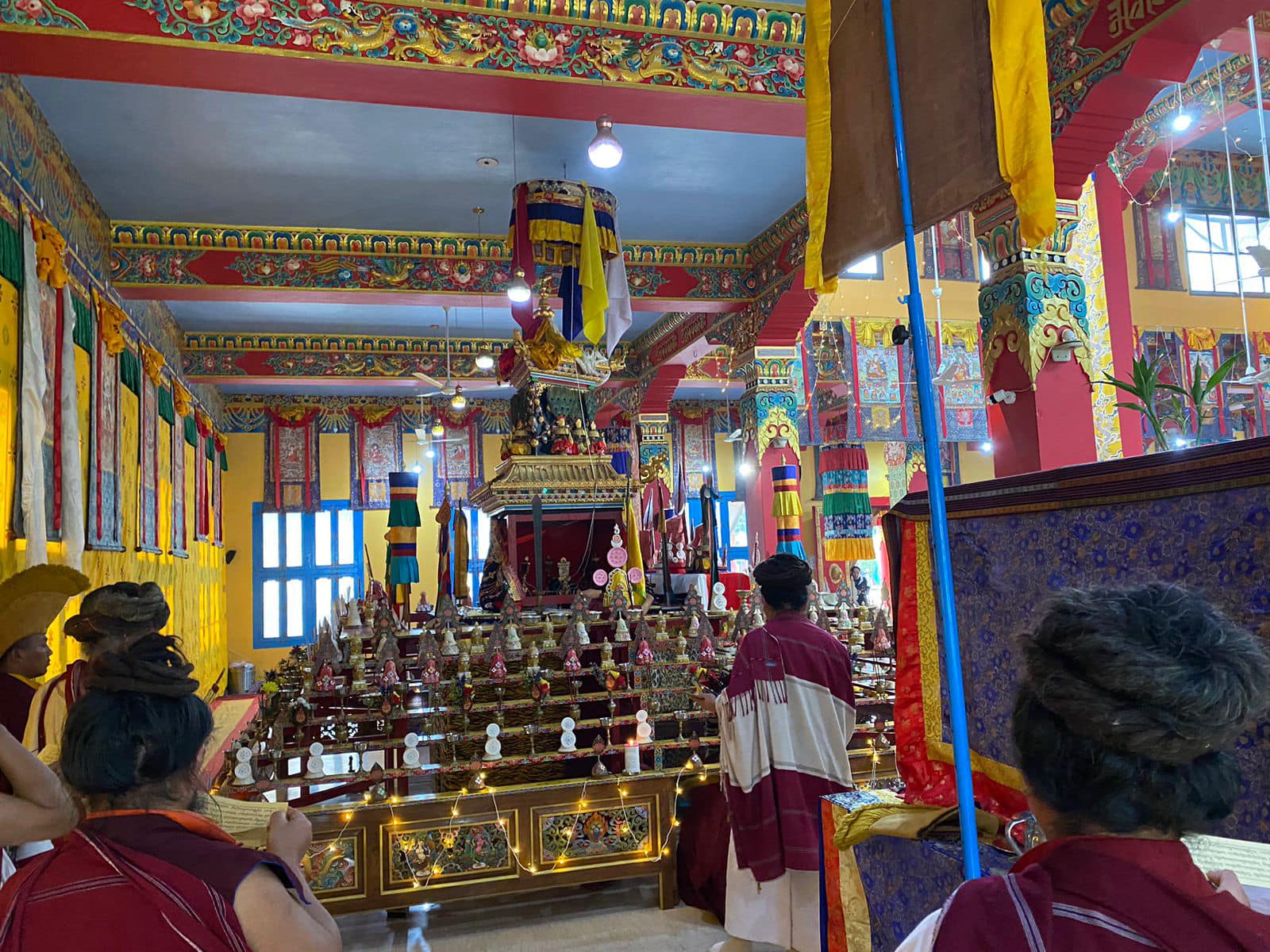
The Kagye Drubchen at Tashi Jong monastery, India started on 11th February and finished on 19th February, the 29th day of the 12th Tibetan month, the Dharma protector day. It was led by the current 9th Khamtrul Rinpoche (more on him below) and the Togden yogis.
I attended the final day of the Drubchen at Tashi Jong monastery, which is about a half hour drive from Palampur, Himachal Pradesh. The morning Tshog ritual was presided over by the 9th Khamtrul Rinpoche, the first time I had met him this lifetime. I arrived there around 9am and as I walked into the main temple, I immediately felt the presence of Vajrakilaya and went into visualisation and mantra.
In the second half of the morning, some very young monks (between 5-7 years old), sat in a row in front of me and it was impossible to contain the giggles and laughter as I watched them, combined with the ritual chanting and music, it was just one endless, spontaneous cackling laughter fest. One young boy in particular, spent the whole time laughing and smiling, especially after his head was ‘bonked’ with the blessing substances by the Togdens, and I felt the same way, it was like a mirror reflection of the Buddha Nature’s innocence, beauty and joy.
At the end of the morning session, when some of the offering edible tormas were slashed open and the blessings from the drubchen were given by Rinpoche and the Togdens, bliss rained and poured down in the entire temple, it was as if the many exquisite and sensual pink and white lotus tormas still intact on the offering shrine (see photos below) were emitting continual bliss. As the loud Gyaling horns rang out during the chanting, it was impossible not to roar the loud AH of the open channel spontaneously bursting out. Like the song of a bird set free!
The afternoon final session was presided by the Togdens alone, finishing with a Marme (butter-lamp) Monlam. As the final crescendo of the slow, deep chants rang out huge, thunderous drums, which I have never heard so magnificent (like a bomb or a cannon firing) blasted through the room, and the sound itself made time stand still, like a gigantic PHET obliterating all negativity and obstacles. As the thunderous drums roared, the shrine of tormas again emitted waves and waves of bliss, as if the deity Kilaya was literally in front of it, or had become it. It was one of the most blissful experiences I have ever had during such a ritual (and that’s saying something!). Here are some photos I took of the shrine and the stunning tormas:




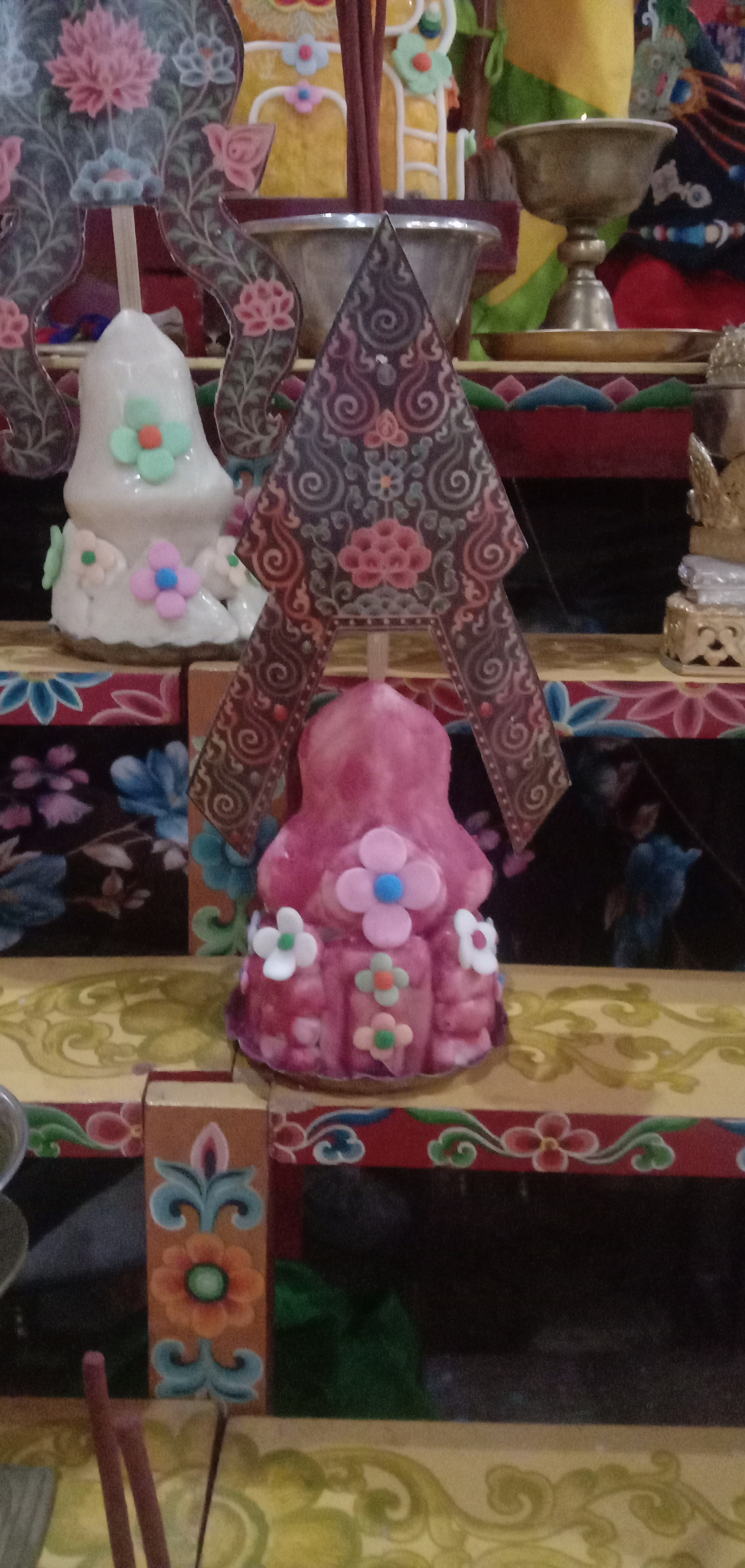






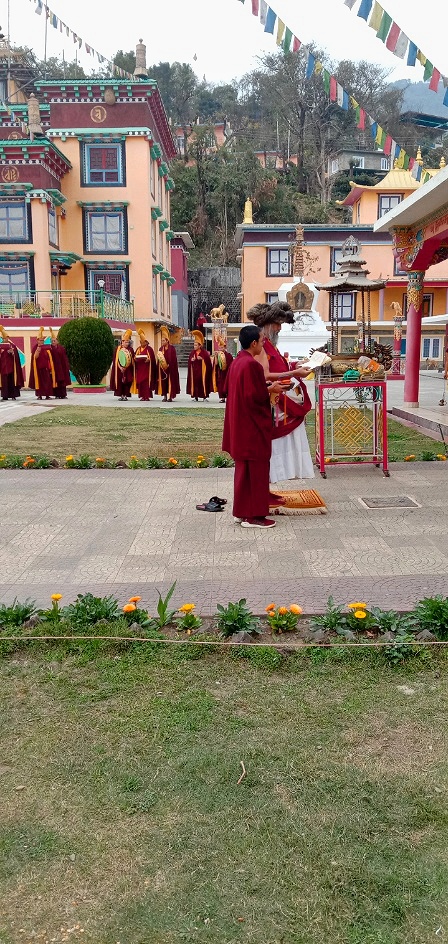


Drukpa Kagyu, the Khamtrul Rinpoche lineage and Khampagar Monastery, Tibet
I wrote a little about the Drukpa Kagyu in Ladakh and the founding of Bhutan here. The Fourth Gyalwang Drukpa Kunkhyen Pema Karpo, head of the Drukpa Lineage, was one of the most celebrated Tibetan Buddhist masters in the 16th century. One of his most accomplished disciples, Lhatsewa Ngawang Zangpo (the First Yongdzin Rinpoche), had numerous disciples. Among those disciples, nine attained the level of realization where there is no distinction between the states of meditation and non-meditation (Gom-Med). One of these disciples was Ngawang Tenphel who became the 1st Khamtrul Rinpoche. Khamtrul means the reincarnation (tulku) from Kham.

The 1st Khamtrul Rinpoche (1659-1627) was born to Yab Khandro Bum and Yum Ri Nyima in Khotsa Rinchengang in Kham. From an early age, he took a liking to wearing the white cotton clothing worn by wandering yogis and would declare that he was a tokden of the Drukpa lineage. This earned him the nickname ‘drukpa’. During his lifetime, the 1st Khamtrul Rinpoche spread his teachings widely in Kham, setting up retreat centers, educational institutes, monasteries and nunneries. There were almost two hundred branches of Khampagar Monastery in Kham region alone due to his work.
As a result of this, he gained a great number of followers. The three main disciples of his were Zigar Sonam Gyamtso, the 1st Zigar Rinpoche, Trulshik Trinley Gyatso, the 1st Adeu Rinpoche, and Drugu Choegyal Gyatso, the 1st Choegyal Rinpoche[3].

The 3rd Khamtrul Rinpoche Ngawang Kunga Tenzin (1680–1728) was responsible for the founding of Pal Phuntsok Choekor Ling monastery in Kham, more popularly known as Khampagar monastery, under the patronage of the King of Lhathog.
The residence of the current 9th Khamtrul Rinpoche Shedrub Nyima in Tashi Jong, Himachal Pradesh, India is likewise known as Khampagar monastery, though its full name is Pal Phuntsok Choekor Ling (for more on that see below).
8th Khamtrul Rinpoche and the establishing of Tashi Jong in exile India

The 8th Khamtrul Rinpoche Dongyud Nyima (1931–1980) was born in Tibet, a few months after his birth, an old master and some monks from Khampagar Monastery visited the family. It is said that the child instantly recognized Ven. Yerab, the old master. Because of this and other auspicious signs, the Regent of the 13th Dalai Lama issued a written declaration affirming the authenticity of the 7th Khamtrul Rinpoche’s rebirth.
The 8th Khamtrul Rinpoche was still quite young when the Battle of Chamdo began in October 1950. He remained in Tibet through the resistance movement in Kham and Amdo in June 1956, but when this was crushed, with serious ramifications for the citizens – including the monks and nuns – he realised he had to leave. In 1958, he left for India with a group of 16 monks and tulkus. The 14th Dalai Lama would leave Tibet soon after following the failure of the 1959 Tibetan uprising.

Initially, the 8th Khamtrul Rinpoche and his followers settled in Kalimpong, West Bengal. There, a number of exiles from the area surrounding the original Khampagar monastery became affiliated with them. In 1969 this community moved west to Himachal Pradesh and settled in a village called Jekhli Beth. The village lies about 10 kilometres (6.2 mi) east of Palampur and about 4 kilometres (2.5 mi) west of Baijnath in the Kangra district of Himachal Pradesh. It is just two hours from the Dalai Lama’s residence in McLeod Ganj. They were granted 37 acres (150,000 m2) of land and named it Tashi Jong, which is Tibetan for “Auspicious (or Happy) Valley”. The area is an historically holy part of Northeast India known as Ngalen gyi Yul.
When the 8th Khamtrul Rinpoche visited Tashi Jong, he is reported to have had a vision of the peaceful and wrathful Manjusri. In the vision, Tashi Jong and its surroundings were formed by a body, speech, mind quality and activity mandala of Manjusri. He took this as a sign to settle there and to re-establish the Khampagar monastery.
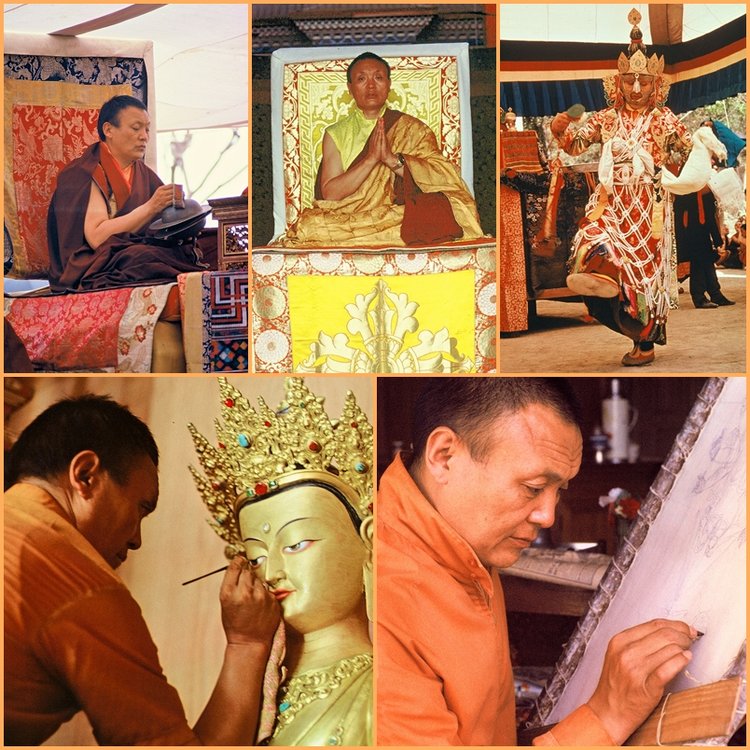
It is said that 8th Khamtrul Rinpoche was a skilled artist and created many of the statues and paintings which can be seen in the monastery today. Tashi Jong has since flourished into a community of 150 monks, both in the monastery and the Khampagar Institute, a school teaching Buddhist philosophy which is connected to the monastery.
The 16th Karmapa is said to have visited Tashi Jong twice, and Dilgo Khyentse Rinpoche visited many times.


Both the 16th Karmapa and Dilgo Khyentse Rinpoche recognised the current 9th Khamtrul Rinpoche, for more on that see below.
After a stay in Bhutan for two years, the 8th Khamtrul Rinpoche passed away on the 5th of January, 1980 at the age of 49. Dilgo Khyentse Rinpoche led the cremation puja of his body.
8th Khamtrul Rinpoche relic stupas at Tashi Jong
There are two relic stupas of 8th Khamtrul Rinpoche at Tashi Jong, one white one outside the monastery:

One is a golden relic stupa inside the temple:


The 8th Khamtrul Rinpoche and his student, Jetsunma Tenzin Palmo
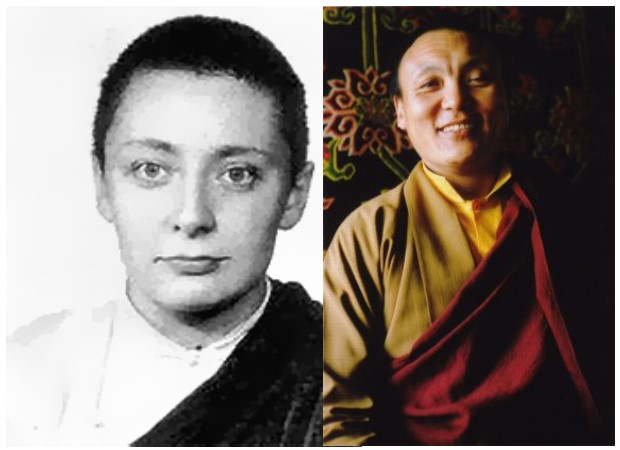
The 8th Khamtrul Rinpoche is also well-known these days as being the spiritual root guru of British born nun, Jetsunma Tenzin Palmo[4]. In 1964, she met the 8th Khamtrul Rinpoche, who would become her root lama. In 1967, she was given the sramanerika ordination at Rumtek Monastery in Sikkim by HH the 16th Karmapa. She was one of the first Westerners to be ordained in the Vajrayana tradition and only the second woman, Jetsunma explains here:
“In 1968 I was a young western nun in my mid-twenties working as a secretary for my lama, the 8th Khamtrul Rinpoche, who had been the head of the 200 Drukpa Kagyu monasteries in Kham, Eastern Tibet. Having left Tibet in 1959 with 25 of his monks, Khamtrul Rinpoche had established a community first in Kalimpong and later in the Kangra Valley not far from Dharamsala where His Holiness the Dalai Lama is situated. At this time Rinpoche headed a small monastery and a community of lay people from his region.
I had first met with the 8th Khamtrul Rinpoche on my 21st birthday and three weeks later received my first monastic ordination when my head was shaved and I donned robes. Then I remained with Khamtrul Rinpoche and his community, working as his secretary and teaching English to the small monks. The monastery in those days had about 80 monks and among them was a small group of yogis who are known as togden. In Kham these togden, although fully ordained monks, lived in caves in the hills above the monastery of Khampagar and they wore long, matted dreadlocks wound up on their heads and white lower robes and a red and white stripped shawl. His Holiness the XVI Karmapa assured me that even in Tibet these particular Khampagar togdens were revered and considered very special. Their lineage is associated with Rechungpa, one of the heart sons of Milarepa.
Rinpoche had told me that in Kham he had a nunnery of about 400 nuns. At this nunnery there was also a group of togdenma or yoginis who were also considered very advanced in tantric practices and realisations. There is a special transmission called the “Rechung Nyen Gyu” [Ras.chung sNyan.brgyud] dealing with the inner yogas which contains a section especially for female practitioners. Actually I have met a few lamas who had visited this nunnery. Males were not allowed direct entrance therein but could sit in a gallery and look down on the assembly hall. They reported that the togdenma sat in rows very straight backed and unmoving during the rituals, with their long dreadlocks hung over a rope stretched behind them.
As far as we know the togdenma lineage ceased to exist in Kham after the communist takeover since no nuns managed to escape into India. One afternoon Khamtrul Rinpoche took a long white silk scarf (ashi khata) and placed it around my neck with the words, “I will always pray that you can re-establish the lineage of togdenmas which, as you know, has died out.” Therefore I have always felt it a sacred commission to bring back this most precious female tradition before it is too late.[5]
In this recent interview, Jetsunma describes a dream she had with the 16th Karmapa, who gave her ordination vows, that gave her insight into the nature of his activity.
Jetsunma’s connection to the Karmapas has continued with the 17th Karmapa, Ogyen Trinley Dorje who visited her nunnery Dongyu Gatsal Ling in 2014, see full report here[6].

9th Khamtrul Rinpoche, Dilgo Khyentse Rinpoche and the Karmapas


The 9th Khamtrul Rinpoche, Shedrub Nyima, born in 1980 in Arunachal Pradesh, was recognized by the late Dilgo Khyentse Rinpoche and 16th Karmapa. He was enthroned by Dilgo Khyentse Rinpoche in Tashi Jong in 1983. I was told by an older monk at Tashi Jong monastery, that Dilgo Khyentse Rinpoche had visited the Tashi Jong monastery many times, and the 16th Karmapa twice.
The 9th Khamtrul Rinpoche received training and instruction from various sources, including from Tokden Amtrin, a highly respected yogi at Tashi Jong (who died on 1 July 2005) and from the late Adeu Rinpoche (the first incarnation of whom was a student of the 1st Khamtrul Rinpoche). Shedrub Nyima currently maintains his seat as the head of Khampagar monastery in Tashi Jong. 
The 9th Khamtrul Rinpoche has also maintained the connection with the Karmapas in this lifetime, hosting a very special event at Tashi Jong in 2013 (see report here), at which the 17th Karmapa, Ogyen Trinley Dorje was the guest of honour. He does not seem to have much of a strong current connection with the current Dilgo Khyentse yangsi, which is odd considering their former connection.
The Togden Yogis and the kudung stupa of Togden Amtin

One of the unique features of the Khamtrul Rinpoche/Drukpa Kagyu lineage are the Togden yogis. Their origin from the time of the 4th Khamtrul is explained here:
“The Khampagar yogi center, called “drubde”, literally meaning “community of practitioners”, was originally started by the 4th Khamtrul Rinpoche (1730-1779), whose name was Chokyi Nyima. After the founding the Khampagar Monastery in the Eastern Tibetan area call Lhathok, he started the retreat center.
From the very beginning, only thirteen yogis entered that retreat center, a number that manifested as an auspicious connection. The 4th Khamtrul Chokyi Nyima’s residence was near the place where the retreat center was built, and before starting it he offered a white torma at the place where he intended to build. Afterwards a self-arisen water source manifested there, and when he offered a torma to vanquish the obstructing forces, he asked his monks to move some rocks to that place. The monks carried up thirteen rocks, which he perceived as an auspicious sign to always have thirteen yogis in this retreat center. The amount of water flowing from its source always remained the same, just enough for thirteen people to sustain themselves. The masters Jampal Pawo and Khamtrul Chokyi Nyima were the teachers of these thirteen yogis, who were called “togden”, meaning “realized one”.
The main practices performed at the Khampagar retreat center are what is known as “Nyengyu” or “Hearing Lineage”, the Six Yogas of Naropa, and Mahamudra. Unless someone at the retreat center passed away, a new yogi could not join.
When the 8th Khamtrul, Dongyu Nyima left Tibet and escaped to India, he took Togdens Choelek, Zopa, Tamchok, Ajam, and Amtin with him. Later on, Togdens Semdor and Achos were able to escape after the Chinese had already reached Khampagar, and after a perilous journey they were also able to join Khamtrul Rinpoche in Kalimpong, India. “
Several of these Togdens have since passed away. For more information about the Togdens who came to India, see here.

There are several Togden yogis at Tashi Jong now in life-long retreat. I walked up to where there retreat house is above the monastery but it was off-bounds to visitors. Nearby the retreat centre was the house of Togden Amtin, a renowned yogi who passed away in 2005. His kudung stupa (containing his body) is housed there, see photos below:


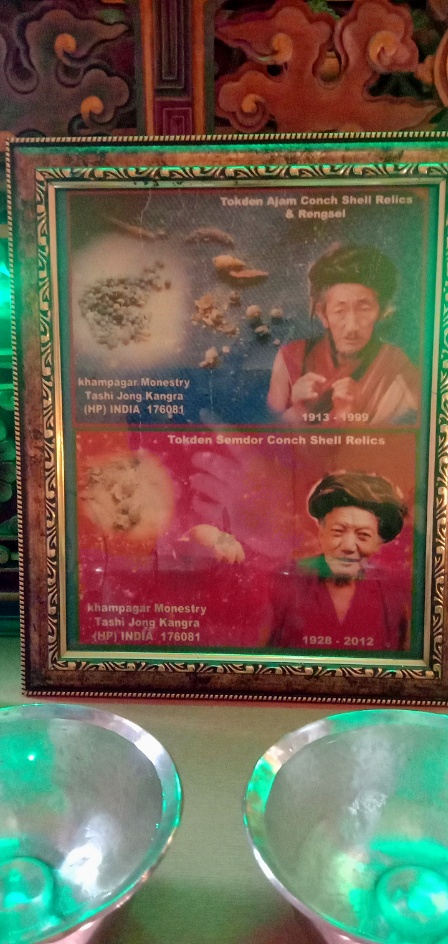


The room had a peaceful, blissful atmosphere inside. I sat on a seat next to the window and saw many green Himalayan parrots outside on the trees, the top of which were the same height as the window. Their green feathers matched the green light on the stupa. The window glass itself had carved birds on it. As I sat there transfixed by the beautiful chirping birds, my heart opened and tears came to my eyes, and I wondered how many times the yogi had sat on this same seat doing the same.
In addition, I had a strong feeling of the presence of the 16th Karmapa, who met Togden Amtin in Tashi Jong twice, who had a particular love for birds. The resident lama in the house told me that the 17th Karmapa, Ogyen Trinley Dorje also visited Togden Amtin who was in retreat then, before he passed away there in 2005.
As I sat there weeping at the beauty and sadness of it all, I heard a soft voice as if coming from the stupa saying: “Help the Karmapa”, to which I mentally replied: ‘I am trying to help him and I will.”



For a story about Togden Amtin and his passing away by Tsognyi Rinpoche read here. Rinpoche reported that “he remained in tugdam for one-and-a-half days; very subtle vital signs were evident.” He explains that:
“Togden Amtin dedicated his life to intensive yogic training at Tashi Jong. Though traditionally togdens only pass their teachings on to the younger togdens of their lineage, through his great kindness Togden Amtin taught and gave instructions to students from all over the world. While at Tashi Jong, Tsoknyi Rinpoche was fortunate to receive teachings from him and realize a strong karmic connection. Tsoknyi Rinpoche considered Togden Amtin to be his second Dzogchen teacher, after his father, Tulku Urgyen Rinpoche. “
Although the Togdens are associated with Drukpa Kagyu, it seems that the Togdens were also important teachers within the Karma Kagyu lineage too. For example, the 1st Zhamarpa was referred to as a Togden, as was one of the main students of the 1st Karmapa, Togden Gyawa Gangpa, see here. More research needs to be done on that.
One thing is for sure, the Togden yogis are a unique feature of the Drukpa Kagyu and their life-long retreat a testament to their enduring commitment to enlightenment and the yidam deity, Vajrayogini.

FURTHER READING/SOURCES
Official Website of IXth Khamtrul Rinpoche
Tashi Jong: A Traditional Tibetan Community in Exile is a 45 min award-winning documentary on the history of Tashi Jong Community released in 1998.
https://tsoknyirinpoche.org/teachings/a-story-about-togden-amtin/
https://www.shambhala.com/snowlion_articles/dongyv-gatsal-ling-nunnery-and-the-yogini-tradition/
https://togdens.org/information/history/
Endnotes
[1] It is said that within the context of Kyépa Mahayoga, Guru Rinpoche taught the eight great sadhana teachings, which were divided into general and particular. ‘General’ refers to the Kagyé as a whole, and ‘particular’ refers to each cycle of the Kagyé deities individually. One cycle is related to Yamantaka, another related to Hayagriva, and so on.
The general cycle was entrusted to King Trisong Detsen after Guru Rinpoche had given him the empowerment at the Samye Chimpu caves. These teachings were later revealed as termas by three of Trisong Detsen’s own incarnations: Nyang Ral Nyima Özer, Guru Chöwang and Rigdzin Gödem. They revealed termas known as the three Kagyé collections (Kagyé Nam Sum), which are ultimately based on the general Kagyé teachings that King Trisong Detsen received from Guru Rinpoche. Nyang Ral Nyima Özer revealed what is known as Kagyé Deshek Düpa, Guru Chöwang revealed the Kagyé Sangwa Yongdzok and Rigdzin Gödem revealed the Kagyé Rangshar.
Apart from King Trisong Detsen, Guru Rinpoche also transmitted the Kagyé teachings and empowerments to all of his twenty-five disciples. Among these, eight showed particular signs of accomplishment in the practice related to one of the Kagyé deities, after their flower had fallen on the corresponding deity in the mandala during the empowerment. Guru Rinpoche gave prophecy and entrusted each one with the complete tantra and sadhana for the cycles they had a connection with. Yeshe Tsogyel was given Vajrakilaya.
[2] Mamo Botong is a deity who is in-between (literally ‘on the border’) the wisdom and the worldly deities and neither male nor female. Jikten Choto and Mopa Drakngak are worldly deities. They are both the manifestation of Vajrapani, but they appear in the form of worldly deities.
[3] It is said that these three Dharma brothers were known as the three oceans. All three lineages still exist and the current lineage holders, especially Choegyal Rinpoche, continue to have a close relationship with the Khamtrul Rinpoche; the 9th Zigar Rinpoche resides at Rewalsar, India, the 8th Adeu Rinpoche died in July 2007 (his next incarnation is yet to be discovered) and the 8th Drugu Choegyal Rinpoche helps Dorzong Rinpoche with the latter’s monastery, known as Jangchub Jong, in Himachal Pradesh, India, and is rebuilding his monastery in Tibet.
[4] Jetsunma Tenzin Palmo, the famed spiritual teacher and activist on behalf of women in Tibetan Buddhism was born in England in 1943 as Diane Perry. Her mother was a spiritualist, which influenced her as a seeker of religious truth in her life. At the age of 18, she read the book The Mind Unshaken: A Modern Approach to Buddhism (Rider 1961) by John Walters. She worked as a librarian after school, including a period at the School of Oriental and African Studies (SOAS) in London. There, she saved money for a trip to India in 1964.
[5] Jetsunma also explains that: “Another time Khamtrul Rinpoche and I were looking out across the hills from Tashi Jong where his community of monks and laity are now situated. Rinpoche remarked that he would like me to establish a nunnery since there was nowhere in our Drukpa Kargyu tradition for nuns to be educated and properly trained. However at that time I merely muttered something incomprehensible since I had neither the means nor the ability to even think how to start a nunnery!
Apart from in Tibet there are also many Drukpa Kargyu areas in the border regions, such as Bhutan (which is called “Drukyul” or “Land of the Dragon” since the state religion is Drukpa Kargyu), Ladakh, Zangskar, Kinnaur, Lahaul & Spiti and parts of Nepal. Although there are nuns in these border lands they are usually uneducated and have little opportunity for meditation practice. Often the nuns are merely household servants or work for the monasteries. I lived for 18 years in the Himalayan valley of Lahaul which lies at about 12,000 feet and is cut off by snow from the rest of India for more than half the year. For the first six years I lived in a small monastery and there I saw how the monks were in the temple receiving teachings, performing rituals and undertaking retreats, while the nuns were in the kitchen doing the cooking! Many of the nuns were intelligent and devoted but they simply had no opportunity to advance their understanding and knowledge.
In the early 90s I returned to India in order to teach English to the 12-year-old reincarnation of Khamtrul Rinpoche. At this time the Lamas of the Khampagar Monastery again requested that I should start a nunnery since there was nowhere in our Drukpa or Dragon tradition for women to study the Dharma and practice at a more profound level. This seemed the right time to consider starting a center where young women from Tibet and the Himalayan border regions could be trained in both Dharma theory and practice.
At that time it was difficult to raise funds for this nunnery since I was an unknown western nun and not a famous lama seated on a high throne dispensing initiations and blessings. Also I had no contacts and it was difficult to know where to begin. However, gradually people began to take interest. Later Vicki Mackenzie wrote a book on my life called Cave in the Snow and this established more credentials for our nunnery project. Nowadays we have a wonderful staff of both western and Tibetan helpers. The nunnery is a registered charitable organisation with local Trust members from Himachal Pradesh.”
[6] The Kagyu Office report states that: “As an auspicious beginning to the visit, Jetsunma Tenzin Palmo, the 8th Dorzong Rinpoche and Togden Chokyi Lodro—the senior Togden yogi of the Khampagar community—offered a long-life puja (tenshug) to the 17th Gyalwang Karmapa, accompanied by 16 arhats offering prayers.
His Holiness spent the remainder of the morning visiting the nuns in the nunnery’s long-retreat center, where five aspiring togdenmas are now in their sixth year of solitary retreat. Escorted into the retreat center by Jetsunma Tenzin Palmo, the Gyalwang Karmapa gave private teachings on Mahamudra to the five retreatants. He then met individually with the five aspiring togdenmas one-by-one, to offer encouragement and personal instructions. He then blessed each of their retreat cells individually, and departed for a brief tour of the remainder of the nunnery, where he blessed the various shrine rooms and library.
The day’s activities resumed after a short break for lunch, as the entire nuns’ community of Dongyu Gatsal Ling was joined by the lamas and monks of the Khampagar Tashi Jong monastery and study institute (shedra) for a special practice session devoted to creating conditions for the nuns’ sangha to flourish. In an assembly led by the Karmapa, the monks and nuns together performed a practice text composed by the Gyalwang Karmapa himself for the flourishing of the nuns’ sangha. The Gyalwang Karmapa compiled the ritual drawing on texts connected to Mahaprajapati Gautami, the first woman to request and receive ordination from the Buddha. Mahaprajapati Gautami’s petition for monastic vows was supported by the intervention of Ananda, the Buddha’s attendant. Accordingly, the practice includes supplications to Ananda, based on a text by Nagarjuna in which Ananda is described as indivisible from Avalokitesvara.”


“The 9th Khamtrul Rinpoche has also maintained the connection with the Karmapas in this lifetime, hosting a very special event at Tashi Jong in 2013 (see report here), at which the 17th Karmapa, Ogyen Trinley Dorje was the guest of honour. He does not seem to have much of a strong current connection with the current Dilgo Khyentse yangsi, which is odd considering their former connection.
9th Khamtrul Rinpoche of Tashi Jong has a very close connection with Dilgo Khyentse Yangsi Rinpoche, I think. Together they received Rinchen Terdzod from Kyabje Taklung Tsetrul Rinpoche at Mindrolling Monastery.
Thank you for the feedback. I have not seen them together much. Receiving a transmission at the same place does not mean they are that close though, right? After all, the previous Dilgo Khyentse Rinpoche recognised the 9th Khamtrul Rinpoche and visited Tashi Jong many times.
the fact that you have not seen also does not mean it is true. there are many photos of them on Facebook. And during at least 3 months of that transmission, they sat next to each other from morning to evening.
Great, hope they remained close after the transmission too. Didn’t see many photos of them together. The former Dilgo Khyentse Rinpoche visited Tashi Jong many times. Who are you and what is your connection with this, why are you so interested in this particular topic?